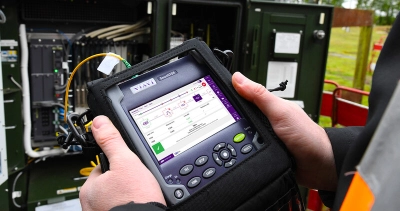The use of ofda optimizes fibre evaluation with advanced optical technology.
Wiki Article
Exploring the Conveniences of Optical Fiber Testing for Boosted Communication Systems
The relevance of optical fibre screening in contemporary communication systems can not be overstated, as it serves as a foundation for ensuring network reliability and performance. This aggressive screening technique has extensive implications for signal high quality and functional efficiency, elevating the concern of just how these practices add to lasting sustainability in an ever-evolving technological landscape.Relevance of Optical Fibre Screening
The importance of optical fiber screening can not be overemphasized in today's data-driven setting. As organizations significantly count on high-speed data transmission for everyday operations, the stability and performance of optical fibre networks are paramount. Examining guarantees that these networks can support the huge amounts of data produced and transferred perfectly, fostering reliable interaction and connection.Optical fiber screening serves numerous essential functions, consisting of validating setup quality, recognizing potential faults, and establishing general system efficiency. Routine screening can avoid costly downtimes and service disturbances, permitting companies to keep operational continuity. In addition, it aids in conformity with sector standards and guidelines, making certain that fibre optic installments satisfy called for specifications for safety and reliability.
In addition, screening can improve the durability of fibre optic systems. By proactively recognizing problems such as signal loss, attenuation, or connector failures, companies can resolve troubles before they intensify, hence prolonging the life of their facilities. In recap, optical fiber testing is not just a technological demand but a critical financial investment that enhances network reliability, optimizes performance, and eventually sustains the development and effectiveness of modern communication systems.
Trick Testing Techniques

OTDR is a crucial method used to identify faults, procedure splice losses, and examine the overall stability of a fibre optic web link. By sending a pulse of light down the fiber and evaluating the reflected light, professionals can determine areas of mistakes and evaluate the network's performance over fars away.
Insertion loss screening measures the quantity of signal loss that takes place when light travel through a link or splice. This approach is vital for confirming that links fulfill specific loss thresholds, which is essential for preserving optimal efficiency in communication systems.
Optical return loss testing evaluates the amount of light mirrored back in the direction of the resource because of imperfections in the fiber or connections. High return loss worths indicate better efficiency and reduced signal deterioration.
Together, these screening methods give a detailed analysis of fiber optic networks, guaranteeing their reliability and performance in diverse interaction applications.
Influence on System Performance
Reliable optical fibre testing straight affects the general efficiency of communication systems. By ensuring the honesty of fiber optic wires, screening determines possible faults such as attenuation, splice loss, and connector misalignment. These concerns can substantially break down signal top quality, causing disturbances and reduced information transmission rates.
Furthermore, routine optical fiber screening adds to long-lasting system sustainability. It allows early detection of deterioration, permitting timely maintenance and upgrades prior to major failings take place. This not just lengthens the life-span of the framework but likewise ensures that interaction systems remain affordable in terms of performance.
Cost-Effectiveness and Efficiency
Cost-effectiveness is an important consideration in the implementation and upkeep of optical fiber networks. Implementing robust optical fiber testing procedures can considerably reduce operational costs by recognizing concerns prior to they rise right into major issues. robotic vision. By identifying mistakes, attenuation, and various other performance limitations early, organizations can avoid costly repair services and downtime, which can interrupt services and result in income lossMoreover, reliable testing methods improve the setup process, enabling professionals to work better. This translates to lower work expenses and faster project completion times. Advanced screening equipment, such as Optical Time Domain Name Reflectometers (OTDRs), allows a precise evaluation of fibre quality, making certain that only optimal products are used, thus reducing waste.
Regular screening also adds to much better source allotment. By understanding the network's performance, companies can make informed choices about upgrades and developments, making sure that financial investments are made where they are most needed. In summary, optical fibre screening improves cost-effectiveness and efficiency, supporting the long-term sustainability and competitiveness of communication systems in a significantly requiring market.
Guaranteeing Long-Term Dependability
Implementing strenuous optical fiber robotic vision testing not only improves expense savings and operational efficiency however likewise plays a critical duty in making certain the long-lasting dependability of interaction networks. Constant screening techniques, including attenuation and transmission capacity evaluations, help recognize prospective degradation in fibre efficiency before it brings about solution disturbances.By utilizing advanced screening approaches, network operators can pinpoint faults or weak points in the fiber framework, enabling timely removal. This positive technique decreases downtime, ensuring that interaction systems continue to be useful and reliable. Regular testing adds to the growth of a more resilient network, as operators can adapt and enhance their infrastructure based on real-time information insights.
Furthermore, making sure compliance with market standards via optical fiber testing reinforces the quality and integrity of the whole communication system. This adherence not just boosts confidence among stakeholders however additionally aligns with governing requirements, which are significantly rigid.
Verdict
In final thought, optical fibre testing serves as an essential part in boosting communication systems. By using various testing methods, such as OTDR and insertion loss assessments, networks can achieve ideal efficiency and integrity. The positive identification of mistakes not just enhances signal high quality but likewise reduces downtime, eventually adding to cost-effectiveness and functional effectiveness. Adherence to market criteria promotes stakeholder self-confidence, making sure the lasting sustainability of communication frameworks in an increasingly data-driven landscape.Report this wiki page